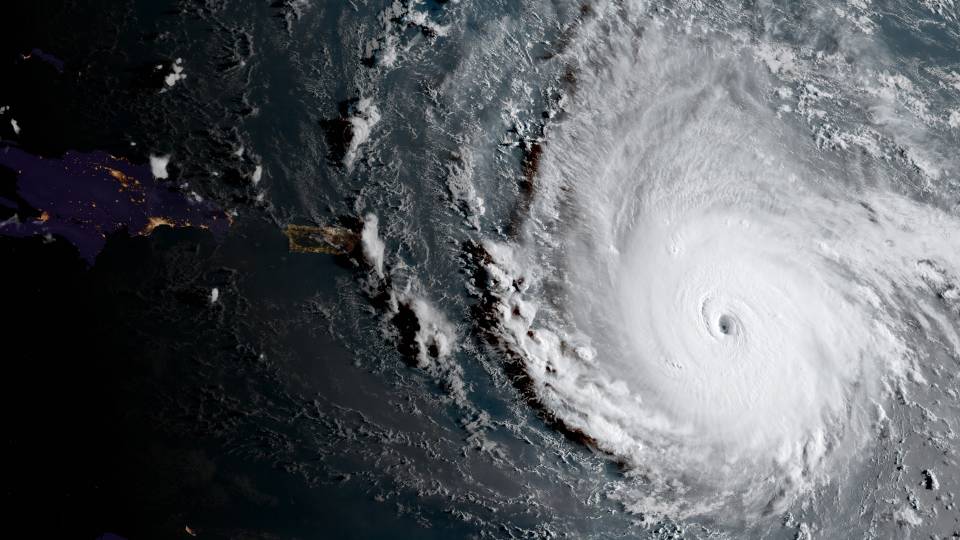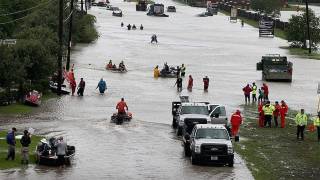Hurricane Irma Makes Landfall in Caribbean
Forecasters call Category 5 storm ‘potentially catastrophic’ with maximum sustained winds of up to 185 miles an hour
Hurricane Irma made its first landfall in the northeast Caribbean early Wednesday after growing into one of the most powerful storms ever recorded over the Atlantic Ocean, prompting evacuations in Florida and disrupting air and sea travel.
The National Hurricane Center called Irma, whose maximum sustained winds increased to 185 miles an hour, a “potentially catastrophic” Category 5 storm. Irma is the strongest hurricane ever recorded in the Atlantic basin outside the Caribbean Sea and the Gulf of Mexico, the agency said, and ranks among the five strongest Atlantic hurricanes.
The storm’s center made landfall over the island of Barbuda early Wednesday, the center said. Heavy rain and howling winds raked the island of Antigua, sending debris flying as people huddled in their homes or government shelters, the Associated Press reported.
A hurricane warning covered an area stretching across a string of islands to the southeastern Bahamas.
Puerto Rico Gov. Ricardo Rosselló declared a state of emergency and activated the National Guard on Monday.
He said public schools and the University of Puerto Rico would be closed on Tuesday. The island’s housing secretary said 456 shelters were available to take in more than 62,000 people.
In Florida, which faces the possibility of a direct strike from the storm, Gov. Rick Scott on Monday declared a state of emergency in all of the state’s 67 counties. Irma could become the most severe hurricane to strike Florida since Andrew tore across the state’s southern reaches in 1992.
Carlos Gimenez, mayor of Miami-Dade County, said the county will begin evacuating special-needs residents Wednesday morning, and he closed county offices on Thursday and Friday.
While Irma churns toward population centers, forecasters are also monitoring Tropical Storm Jose, a newly formed storm in the more distant Atlantic. It could become a hurricane by Thursday. Early Wednesday the National Hurricane Center said a third weather system, Tropical Storm Katia, had formed in the Gulf of Mexico and is expected to strengthen over the coming days.
Miami Beach Mayor Philip Levine made a personal appeal Tuesday for residents and tourists to leave the island as soon as they could, in advance of what he expects will be a mandatory evacuation order from Miami-Dade County. The mayor said there are few roadways on and off the island, and he wanted to minimize congestion.
Officials in Miami Beach began distributing sandbags to residents on Tuesday, while supermarkets received a growing stream of customers stocking up on water, canned foods and batteries.
Authorities in Broward County, north of Miami, urged residents in evacuation zones to leave and stay with family and friends elsewhere. School officials in Miami-Dade and Broward also canceled school for Thursday and Friday.
In the Florida Keys, Monroe County officials said Tuesday they would be issuing a mandatory-evacuation order for tourists and residents, with the exact times still to be determined.
Mr. Scott activated 100 members of the National Guard on Tuesday to help with storm preparation and directed all 7,000 guard members in the state to report for duty on Friday morning. And he told transportation authorities to suspend tolls on roads throughout the state.
The threatening storm caused cruise lines to cancel and divert sailings in the popular Caribbean. Airlines on Tuesday were canceling flights in the region and offering waivers to passengers in Florida.
Irma is forecast to dump up to a foot of rain in the northern Leeward Islands, with isolated instances of 20 inches. Drenching rains are also forecast for parts of Puerto Rico, the British and U.S. Virgin Islands and others, according to the hurricane center. The rainfall could trigger life-threatening flash floods and mudslides.
The Turks and Caicos Islands and southeastern Bahamas could see storm surges of 15 to 20 feet, as well as large, destructive waves, forecasters said.
The northern coast of Puerto Rico could experience a storm surge of 3 to 5 feet.
In Puerto Rico, which declared a form of bankruptcy earlier this year, the severe economic crisis battering the island could play a role in how people experience the consequences of the hurricane, analysts say.
“The electricity infrastructure has been notoriously weak over the last year or so,” said Vicente Feliciano, president of Advantage Business Consulting, an economics consulting firm in San Juan. He said the utility has had to reduce its capital and maintenance expenditures to make payments to bondholders.
Residents of Puerto Rico were bracing for significant power outages after the head of the island’s electrical utility told a local news outlet that it could take three to four months to restore power in some areas.
In an effort to stabilize the island’s rocky finances, Puerto Rico’s government and municipalities have cut back on staffing in a wide range of areas, from utility crews to emergency personnel, said Edwin Meléndez, director of the Center for Puerto Rican Studies at Hunter College in New York. If Irma generates “the worst possible scenario, Puerto Rico might not be ready to weather the storm,” he said.
The Federal Emergency Management Agency said Tuesday that it had staff and supplies, including water and meals, in place in Puerto Rico and the U.S. Virgin Islands.
In Florida, Mr. Scott said he spoke Tuesday with state and national emergency officials, including FEMA Administrator Brock Long. “They assured me that Harvey response will not impact their response to Florida,” Mr. Scott said.
The state is working on preparation, he said, including preparing 1,000 high-wheeled trucks to help with rescues and accepting an offer from the American Red Cross to send 1,000 volunteers to Florida.
Mr. Scott asked residents to stock up on supplies and make a plan to evacuate. “This storm has the potential to devastate this state,” he said. “You can get new possessions, but you can’t rebuild your life.”






















